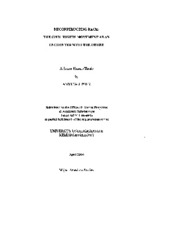| dc.description.abstract | This paper examines perspectives of four different leaders during the American Civil Rights era and discusses how the men employing each perspective defined and encountered the Other. One can define "the Other" as any person or group whom a human perceives as different in some way from himself, and the term "race" marks one complicated way of classifying self and other into specific groups. In dealing with the theoretical aspect of otherness, or alterity, this paper relies largely on the writings of Tzvetan Todorov and his assertion that an ethical understanding of the Other perceives it as both equal and different. By researching the rhetoric of two white leaders and two black leaders, I attempt to determine how race affected different views of the Other in 1960's America. Robert Kennedy, John Lewis, Stokely Carmichael, and Eugene "Bull" Connor each provide different opinions about how one should define and deal with the Other. As a powerful white man working within the establishment, Robert Kennedy was an important ally to Civil Rights leaders. However, Kennedy's attempts to bring blacks into mainstream America often denied their difference. Both Carmichael and Connor approached their racial other as inferior and therefore violated Todorov's requirement to see the Other as equal. Finally, John Lewis and his nonviolent philosophy did not define the Other merely along racial lines. Although Lewis engaged in a sort of self-projection, his refusal to define alterity strictly according to race helps the observer to see that race may not work as a tool to explain human diversity. This issue holds major importance for America's past, present, and future because racism has long plagued the country and because encounters with otherness occur frequently in our global community. By understanding race as a false and arbitrary marker of human groups, one which does not truly reflect differences in mental processes and perspectives, scholars can hopefully begin to gain a fuller understanding of human diversity and how it functions. | en |


